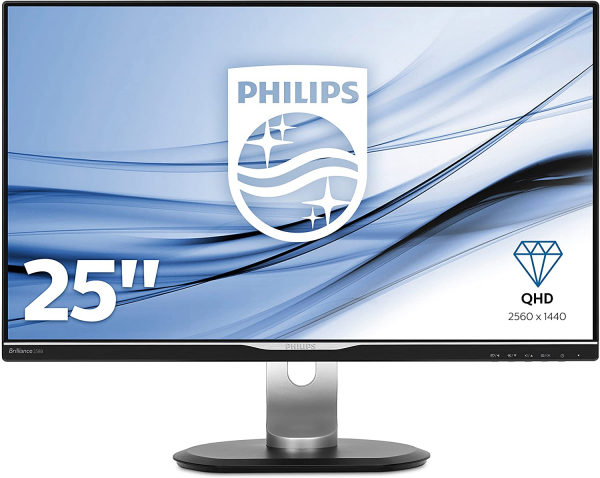Philips
Philips Brilliance 258B6QUEB: a real USB-C docking station
Aprox. 386€
See specificationsUSB-C has a single goal: to replace all cables and ports with a single, universal one. Put into practice on the Philips 256B6 monitor and preview what awaits us in the near future.
Positive points
Image quality.
Ergonomics.
Viewing angles.
Comfortable definition, even if quite fine.
True full USB-C docking station (charging, video, USB 3.0 and Ethernet).
Bad points
Limited contrast.
No USB ports on the edge.
Our review
Presentation
The Philips Brilliance 258B6QUEB monitor is rather unique on the market since it completely replaces a USB-C docking station. In addition to its full video connectivity, it has a USB-C port, three USB 3.0 ports and a Gigabit Ethernet port. At the screen level, this monitor has a 25-inch IPS panel displaying a Quad HD definition of 2,560 x 1,440 px and operating at a conventional refresh rate, limited to 60 Hz. The 258B6QUEB incorporates the full ergonomics of Brilliance models with an adjustable foot in all directions and a swivel in pivot mode.
The Philips Brilliance 258B6QUEB that we tested is sold at around 450 €; a high price for a 25 inch Quad HD monitor, but which is justified by its ergonomics and especially by its integrated connectors.
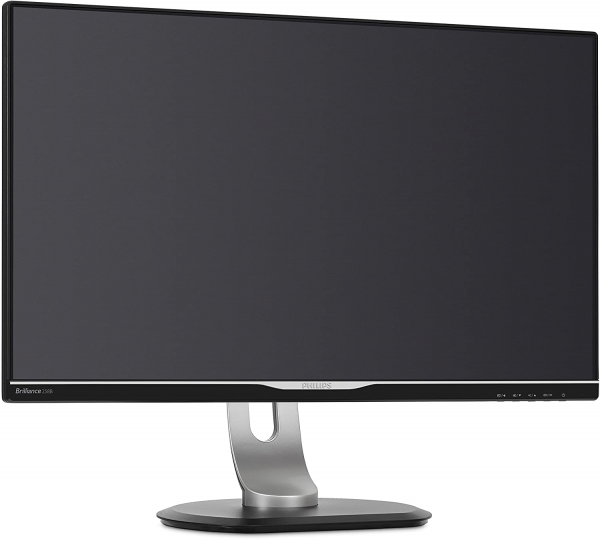
Ergonomics
The design combining black and gray plastics is very classic. The finishes are good and the different elements are well adjusted. The semi-glossy slab benefits from a fairly effective anti-reflective treatment.
The rear design is extremely refined. He is completely black. The hole at the base of the foot is used to pass the cables and therefore serves as a fairly basic cable management system.
The ergonomics are exemplary. The foot is adjustable in height by 13 cm, the tilt between -5 ° and + 20 °, the rotation by about ± 65 ° and the monitor can rotate in portrait orientation. The various adjustments are made smoothly and without squeaking.
All the connections are grouped at the back of the screen. It consists of an audio input and output, an HDMI input, a DVI Dual-Link input, a VGA input, a DisplayPort input, a USB-C port, three USB 3.0 ports and one Gigabit Ethernet port. The connectivity is therefore very complete and the only criticism that can be made of this monitor is that it does not offer USB ports directly on the edge to facilitate the use of removable USB devices such as USB keys or external hard drives. The screen also has two 2-watt speakers whose quality is just enough to watch a video, but they do not replace a PC speaker kit. This monitor acts as a docking station for portable computers with a USB-C port, ensuring charging, video transmission and duplication of the USB ports via a single cable (see box).
The five touch keys on the front panel allow you to turn on the screen and access the settings. This system is not the most practical and handling errors are common. Fortunately, the menus are clear and the proposed settings are numerous (brightness, contrast, blue light filter, sensitivity of the presence detector, temperature, gamma, overdrive ...).
We have measured consumption at around 24 watts with a white set at 150 cd / m². Relative consumption thus reaches 139 W / m². This is less than the average of the screens tested (150 W / m²), but it is a little more than the consumption of the last screens which do not exceed 100 W / m². For use 8 hours a day, 5 days a week, this represents a little more than 5 € per year. At maximum brightness (343 cd / m²), it consumes 38 W and 18 W minimum (79 cd / m²). Obviously, by connecting a laptop via USB-C, consumption increases drastically since the monitor is then responsible for recharging it. Connected to ZenBook 3, the monitor consumes 44 W while consumption rises to 80 W when connected to a Specter x360 2016 or a 13-inch MacBook Pro (without Touch Bar).
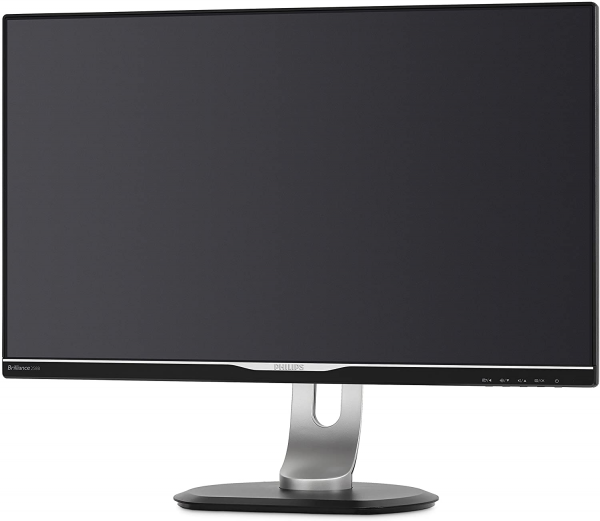
Colors and contrast
Default: average gray temperature: 6.830 K
Default: gamma curve at 2.2
Default: Average Delta E at 1.6
By default, the Philips Brilliance 258B6QUEB monitor is very well calibrated. The temperature curve is perfectly stable over the entire spectrum and the average recorded (6,830 K) is fairly close to the 6,500 K reference. The gamma curve is a model of stability on the reference value (2.2) with the exception of a small off-hook on the very light gray which does not really affect the final rendering. Finally, the average Delta E is only 1.6, only green, red and pure blue are above 3 and only the drift of red is really noticeable. Overall, the Delta E is therefore less than 3, a threshold below which the human eye no longer distinguishes between colors.
Manual adjustment: average gray temperature: 6,800 K
Manual adjustment: gamma curve at 2.2
Manual adjustment: Delta E medium at 1.6
By lowering the brightness to 26, we obtain a white at 150 cd / m² on our test pattern. The decrease in brightness does not change the behavior of the screen, which still provides a good rendering.
Calibrated: average gray temperature: 6,760 K
Calibrated: gamma curve at 2.2
Calibrated: Delta E medium at 1.6
Calibrating the monitor to the probe slightly stabilizes the gamma curve by improving the fidelity of the light gray. If the blue finally drops below a Delta E of 2, the average delta E remains at 1.6. The temperature is a little closer to the reference value at 6,760 K. The color profile can be downloaded from the Focus Numérique website.
The contrast of this IPS panel is correct (1070: 1). Some IPS monitors, especially in PLS (Philips 276E7), sometimes do better (1300: 1). As with all IPS monitors, blacks lack depth. This has no impact when used in daylight, but in the dark, blacks appear gray. For better contrast, you should turn to monitors using a VA panel like the Eizo Fortis FG2421 or the BenQ BL2410PT whose contrast exceeds a rate of 3000: 1.
We measured the average difference in brightness uniformity at only 6% over the entire 25-inch panel; very good value. We did not see any clouding phenomenon on the model we tested. Finally, as always with IPS panels, the viewing angles are exemplary and there is very little variation in brightness when you are positioned at 45 ° from the display axis.
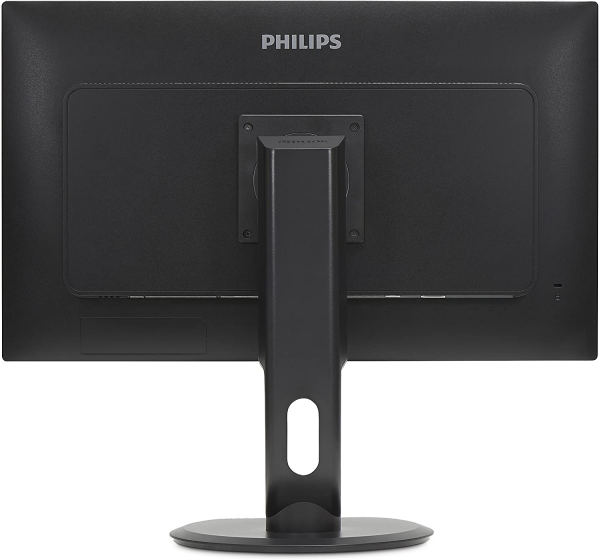
Reactivity
The Philips Brilliance PHL258B6QUEB does not use Pulse Width Modulation (PWM) to adjust the brightness. So there is no flickering when the brightness is reduced and it does not cause headaches for people who are sensitive to it. However, this monitor does not offer a mode to reduce the emission of blue light.
We measured the remanence time at 10.5 ms with the setting of the overdrive (response time) to "Faster". This setting reduces the ghosting effect without causing reverse ghosting, unlike what happens with an even more advanced setting (the fastest). We also measured the delay on the display (input lag) at 10 ms, an excellent value. There is thus no lag between the action performed on the keyboard or the mouse and its repercussion on the screen.
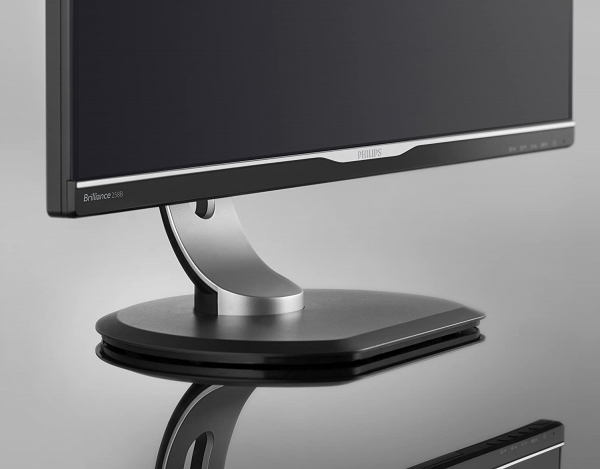
Conclusion
In addition to being an excellent monitor, the Philips Brilliance 258B6QUEB is also a quality USB-C docking station. Given its relatively high price, it is for this capacity that it will be chosen. But with this in mind, it is the perfect companion for a laptop computer equipped with a USB-C port.
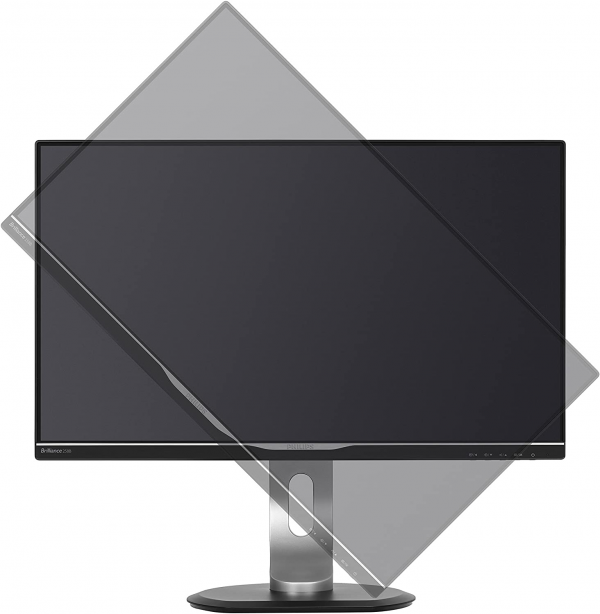
Specifications

